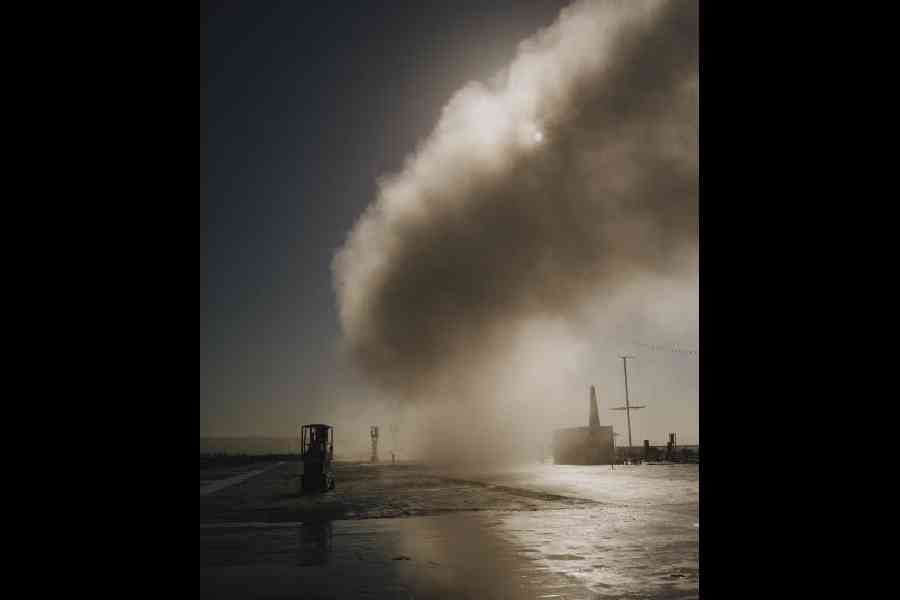A little before 9am, an engineer named Matthew Gallelli crouched on the deck of a decommissioned aircraft carrier in San Francisco Bay, US, pulled on a pair
of ear protectors, and flipped a switch.
A few seconds later, a device resembling a snow maker began to rumble, then produced a great and deafening hiss. A fine mist of tiny aerosol particles
shot from its mouth, travelling hundreds of feet through the air.
It was the first outdoor test in the United States of technology designed to brighten clouds and bounce some of the sun’s rays back into space, a way of temporarily cooling a planet that is now dangerously overheating. The scientists wanted to see whether the machine that took years to create could consistently spray the right size salt aerosols through the open air, outside of a lab.
If it works, the next stage would be to try to change the composition of clouds above the Earth’s oceans.
As humans continue to burn fossil fuels and pump increasing amounts of carbon dioxide into the atmosphere, the goal of holding global warming to a rela-
tively safe level is slipping away. That has pushed the idea of deliberately intervening in climate systems closer to reality.
Universities, foundations, private investors and the US government have started to fund a variety of efforts, from sucking carbon dioxide out of the atmosphere to adding iron to the ocean in an effort to store carbon dioxide on the sea floor.
“Every year that we have new records of climate change, and record temperatures, heat waves, it’s driving the field to look at more alternatives,” said Robert Wood, the lead scientist for the team from the University of Washington that is running the marine cloud brightening project.
Brightening clouds is one of several ideas to push solar energy back into space — sometimes called solar radiation modification, solar geoengineering or climate intervention. Compared with other options, such as injecting aerosols into the stratosphere, marine cloud brightening would be localised and use relatively benign sea salt aerosols as opposed to other chemicals.
And yet, the idea of interfering with nature is so contentious, organisers of the San Francisco test kept the details tightly held, concerned that critics would try to stop them. Although the Biden administration is funding research into different climate interventions, the White House distanced itself from the California study.
In 1990, a British physicist named John Latham published a letter in the journal Nature, under the heading “Control of Global Warming?,” in which he
introduced the idea that injecting tiny particles into clouds could offset rising temperatures.
Brightening clouds is no easy task. Success requires getting the size of the aerosols just right: particles that are too small would have no effect, said Jessica Medrado, a research scientist working on the project. Too big and they could backfire, making clouds less reflective than before. The ideal size are submicron particles about 1/700th the thickness of a human hair, she said.
Next, you need to be able to expel a lot of those correctly sized aerosols into the air: a quadrillion particles, give or take, every second. “You cannot find any off-the-shelf solution,” Medrado said.
The answer to that problem came from some of the most prominent figures in America’s technology industry.
In 2006, Microsoft founder Bill Gates got a briefing from David Keith, one of the leading researchers in solar geoengineering. Gates began funding Keith and Ken Caldeira, another climate scientist and a former software developer, to further their research.
The pair considered the idea of marine cloud brightening but wondered if it
was feasible.
So they turned to Armand Neukermans, a Silicon Valley engineer with 74 patents. One of his early jobs was at Xerox, where he devised a system to produce and spray ink particles for copiers. Caldeira asked if he could develop a nozzle that would spray not ink, but sea salt aerosols.
Intrigued, Neukermans, who is now 83, lured some of his old colleagues out
of retirement and began research in a borrowed lab in 2009.
Their work moved to a larger laboratory. Medrado became the lead engineer for the project two years ago. By the end of last year, the sprayer had been assembled and was waiting in a warehouse near San Francisco.
The machine was ready. The team needed somewhere to test it.
The flight deck of the Hornet rises 50 feet above the shore of Alameda, on the east side of San Francisco Bay. A few days ago, it held a series of finely calibrated sensors, perched atop a row of scissor lifts reaching into the air.
Underneath a US flag at the far end of the flight deck was the sprayer: shiny blue, roughly the shape and size of a spotlight, with a ring of tiny steel nozzles around its three-foot-wide mouth. The researchers call it CARI, for Cloud Aerosol Research Instrument.
On one side of the sprayer was a box the size of a shipping container that housed a pair of compressors, which fed highly pressurised air to the sprayer through a hose. On the other side was a tank of water. A series of switches, turned in careful sequence, fed the water and air into the device, which then shot a fine mist toward the sensors.
The goal was to determine whether the aerosols leaving the sprayer, which had been carefully manipulated to reach a specific size, remained that size as they rushed through the
air in different wind and humidity conditions. It will take months to analyse the results. But the answers could determine whether marine cloud brightening would work, and how, according to Wood.
NYTNS











